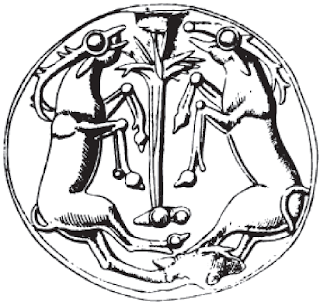In this book, the author Alexander Carmichael recorded a tune, still popular today especially among pipers, called Cailleach an Dùdain (The Old Woman of the Mill-Dust).
You can hear the song here, and here is the note sheet.
Here are the lyrics. I couldn't translate one of the lines
In my post "Gryla" I talked about the Old Hag Winter from European folklore.
I mentioned that in Gaelic lands of Ireland and Scotland her name was Cailleach.
But Cailleach is also a name for a Corn dolly in Irish and Scottish folklore.
At the end of the article about Cailleach corn dollies, I talked about the folk play from Slovenia called "Babji mlin" (Grandmother's mill, or mill for milling grandmothers) in which "an old woman was transformed into a young girl through milling"
In the Slovenian folk play an old woman gets transformed into a young girl through milling.
In the Gaelic folk song "Old woman of mill dust" an old woman is asked to give her daughter away.
How should we understand these two allegorical images?
Like this: In Slavic mythology, there is really only goddess: Mother Earth. But she has three faces. She is young virgin girl, Vesna (Spring), mature fertile woman, Mokosh (Summer, Autumn) and old barren old woman, the hag, Morana (Winter)...
The harvest happens in the summer and autumn and the harvested grains are milled over the winter and spring to make bread. Which is why milling is symbolically used the Slavic ritual play to describe passage of time which turns winter (Grandmother into spring (Maiden).
I believe that "Old woman of mill dust" was a Gaelic ritual song, sang during the reenactment of the transformation of the Old Hag Winter Earth into Young Maiden Spring Earth, probably during Imbolc (beginning of spring) festival...
That this is indeed the case, can be seen from the fact that elsewhere in Carmina Gadelica, Carmichael has a long note about the curious ‘resurrection’ dance which accompanied the playing of this jig:
In this curious dance, the woman playing the Old Hag Winter Earth (Old Lady of the mill dust, flour) dies and is then revived (gives her daughter away), is turned into Young Maiden Spring Earth, by the young man playing the Young Sun...
Remember in Slovenian "Milling of the grandmother" ritual play depictions, it is always young men who bring the Old Hag to the mill and take away the Young Maiden...
This is truly incredible. This is a remnant of the old European religious rituals which were once probably performed throughout Europe, but were to our days only preserved in Scotland and in Slovenia. Again Slavs and Gaels...We find this toooo often to be a coincidence...
I will finish this article with the great picture entitled: "Cailleach aig a bheil cailleach" (An old woman with a last sheaf of wheat) from Carmichael Watson Project page about the Cailleach an Dùdain. Cailleach means both an old woman, and the last sheaf of wheat and the corn dolly made from it. Corn dolly which represents Mother Earth, the life, birth giving mother of all...









































































